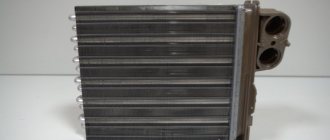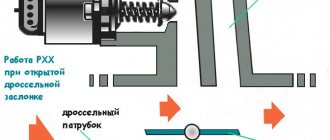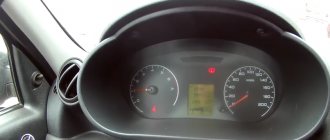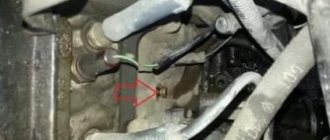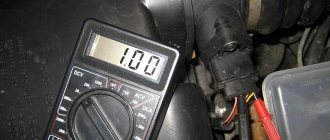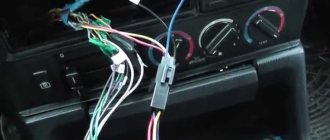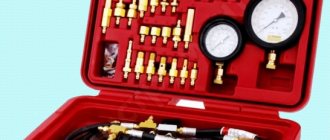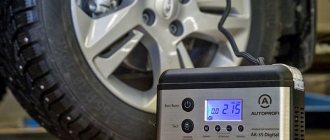Factors influencing floating speed
When you turn on the car, the engine warms up quickly to reach the optimal temperature .
After which, using the electronic control unit, the speed is reduced to normal values. When for some reason the unit does not work, you need to find out the cause of the malfunction. Increased intensity of engine operation leads to disastrous results - thermal shock, malfunction in the cylinder block, accelerated depreciation.
When the idle speed fluctuates in a Chevrolet Niva with an injector, the reasons may be as follows :
- malfunction of the idle air regulator (IAC);
- failure of the throttle position sensor (TPS);
- difficulties in adjusting the remote sensing angle;
- broken engine temperature sensor (DTOZH);
- damage to the intake manifold.
Another possible problem is a malfunction in the electronic control unit.
The main reasons why the idle speed of the VAZ 21214 floats
The question of why the idle speed is floating is perhaps the most frequently asked question regarding the engine. Indeed, problems with idle are a common occurrence that car owners have to deal with.
The most unpleasant thing is not that this is very serious or that repairs will be too expensive and time-consuming, but that there can be a lot of reasons why the idle speed is floating. In this article I will try to help you find and eliminate the cause of unstable engine speed, so that you save your time and nerves.
Read more: Alfa romeo v6 24v
Why don't the revs drop?
There are quite a lot of reasons for the appearance of such an unpleasant phenomenon, let's try to understand this issue together and decide how to get out of this situation. Most often, in injection engines, speed reduction does not occur due to the fault of the throttle assembly, in which contamination occurs. Old engines, worn out by time, most often suffer from this. Engine oil is released into the power system, it burns in the intake tract and prevents the damper from moving into place. Because of this, an unauthorized supply of the fuel mixture to the engine cylinders occurs, which leads to an increase in idle speed.
Troubleshooting Methods
You can solve problems with jumps and floating speeds yourself:
- To confirm and eliminate the possibility of air leaks from the outside, check the supply system for leaks. Using a compressor or pump, supply air to the removed hose placed in water. This allows cracks to be detected.
- The resistance of the IAC is measured. Values within 40-80 Ohms indicate that the device is not working.
- During the diagnostic process, the crankcase gas ventilation valve is cleaned. It is removed and washed with kerosene or carburetor cleaner.
- When sensors fail, they are not repaired, but replaced immediately.
- If the throttle valve requires washing and removal, it is recommended to entrust the job to a specialist. Without removing the damper, you can wash the part yourself using a cleaning aerosol.
- Adjust the idle speed by setting the “quantity” and “quality” screws on the carburetor. Clean the nozzle with an aerosol and blow it out with compressed air.
Important! All conductive contacts are disconnected from the throttle valve. In case of heavy contamination, after cleaning, set the required gap.
In most cases, eliminating these causes helps to get rid of floating speed.
Damage to the intake manifold.
The collector itself may also fail if the car has a sufficiently long service life. But more often the gasket fails. In this case, excess air is sucked in. To fix the problem, it is necessary to dismantle this part, as well as the units on which the injection elements are located. Before installing the gasket, it is necessary to thoroughly sand the surface of the manifold and clean it of traces of the old gasket. But it is important to remember that the occurrence of this problem is accompanied not only by increased idle speed. Damage to the gasket makes it difficult to start the engine and the speed fluctuates while driving.
As can be seen from practice, there are a very large number of problems that can cause increased idle speed on a warm engine. Therefore, if there are doubts that self-repair will not bring the desired result, it is better to entrust the car to specialists who, with the help of professional equipment, will be able to quickly identify the defect and eliminate it.
Procedure for removing the device.
To remove this device, you need to stock up on a small set of tools, consisting of a 13mm socket wrench, a screwdriver and pliers.
- Place the vehicle on a flat surface and secure it with the parking brake. If there is any doubt about the stability of the car, you need to install wheel chocks.
- After this, you need to disconnect the battery terminals.
- We unscrew the fastening nuts and studs that secure the receiver to the throttle valve. In this case, there is no need to disconnect the pipes of the cooling and crankcase ventilation system.
- Disconnect the terminals from the wires
- Using a Phillips screwdriver, unscrew the valves on the throttle valve
- When the device mount is unscrewed, you can remove it from its seat. Usually, you can get the O-ring along with it. But, in some cases, it may get stuck in the damper well.
- In this case, it is necessary to carefully dismantle it.
Diagnostics of DXX
Often, problems with the idle air control valve are confused with a breakdown of the throttle position sensor . A distinctive feature is that the “Check Engine” indicator on the dashboard lights up in the event of a failure of the throttle position sensor.
The following signs indicate a breakdown of the idle air regulator::
- strongly floating speed when starting the car;
- when the heater and headlights are turned on, the revolutions drop below 500 per minute;
- If the car has not been driven for a long time when the ignition is turned on, the engine runs at low speeds without warming up.
If at least one point matches, it is necessary to check the DXX.
To check the functionality, measure the voltage supplied to the regulator :
- The Chevrolet Niva is placed on a level surface and the parking brake is raised.
- The terminals are removed from the IAC.
- Using a multimeter, connect the connectors alternately.
- Turn on the ignition and look at the tester values.
- Normal voltage is considered to be 12 W. Indicators less than 12 indicate a low battery.
- If there is no voltage, check all wiring for an open circuit.
- Test the resistance at the IAC outputs one by one. In good condition it shows 53 ohms.
If the regulator is faulty, it is replaced with a new one.:
- the car is put on the handbrake;
- remove the negative terminal from the battery;
- unscrew the nuts from the throttle studs without disconnecting the pipes;
- remove the terminals from the idle speed regulator;
- unscrew the screws securing the car sensor;
- take out the device.
The new device is assembled in the reverse order.
How to Start 2114 Without a Key
There are various unexpected situations in life, and from time to time we lose our car keys. According to the law of the falling sandwich, this most often happens in nature or in a summer cottage. How to solve this problem? What can be done and how to start a VAZ 2114 without a key? There are several methods, they differ in the point of access to the car's power supply and how it is connected.
Twist
To twist, you will need a Phillips screwdriver and a paper clip (a piece of wire).
- Open the hood and remove the wire from the positive terminal of the battery.
- Place the gear shift lever in neutral position.
- Put the car on the parking brake.
- Using a Phillips screwdriver, remove the speaker control cover and set it aside.
- Carefully remove the block with wires from the ignition switch. Immediately determine which wire is grounding and disconnect it from the others. If you connect the ground to the housing with a multimeter, there will be no voltage. It's even better if you insulate the cable so that you don't accidentally destroy all the wiring.
- Find the reddish wire and move it to the side. Carefully connect the remaining wires so that there is contact. Secure the twist with wire or a paper clip. From time to time, the twist is rewound with tape or tape. Your car's electrical equipment should turn on.
- Depress the clutch pedal.
- Place the reddish wire with the rest of the wires (twisted). The car should start. Remove the reddish wire from the twist. If the engine speed is steady, release the clutch pedal smoothly and carefully.
THIS IS INTERESTING: Nissan Qashqai replacing stabilizer bushings
The ignition switch connectors (blocks) on different cars may differ from each other. There are types of connectors from which you can remove the wires with an awl. Only after removal are they twisted together (without the reddish wire).
How to Start 2114 Without a Key
After starting the engine, the reddish wire is immediately removed from the twist. Otherwise, the starter may break.
Attention! If you do not remove the wire from the battery terminal, when twisting the wires, the engine may start and a short circuit may occur.
Drilling the ignition switch
Drill out the ignition switch with a drill, pointing it slightly above the keyhole. This will destroy the locking pins of the lock. Repeat the operation a couple of times and later turn a narrow screwdriver in the lock. The car should start.
The ignition switch must be replaced after drilling. Some models will cost more than calling a tow truck.
Powered directly from the battery
Another method on how to start 2114 without a key. Connect the ignition coil wire (under the hood at the bottom, approximately in the center) and the positive battery. The ignition should turn on. From the starter terminal, run a wire to the battery positive, power the starter, and the engine should start.
Using a metal plate
A plate similar in size to the iron part of the ignition key is inserted into the ignition switch. The protruding part of the plate is turned with force with a screwdriver, like a lever, to break the lock. The plate is twisted in the same direction as the key. After turning the plate, the car should start.
Apart from solving problems with starting, you will have to remove the action of the steering lock by making sharp turns from the last right to the last left position and back.
To remove the car from the alarm system, you need to switch the alarm button to the “Vallet” mode.
The most common method without destructive actions and subsequent repairs is to power the ignition coil and starter directly from the battery.
Errors in power connections can damage sensors and electrical equipment.
If the car has an onboard brake so that it does not burn out, it is better not to start it in this way, but to call a repairman or a tow truck.
Finally
In order to make the right decision, it is worth using such methods of starting the machine, you need to calculate and compare the damage from the loss of time and the costs of repairs that will have to be done after an emergency start.
These methods of how to start a VAZ 2114 without an ignition key are mainly suitable for cars produced in the 80s and 90s. The following models have steering locks, starter locks, etc., and even if you use one of these methods, most likely you will not be able to go anywhere.
Source: https://top-geer.ru/kak-zavesti-2114-bez-kljucha/
We are looking for the reason why the idle speed on the VAZ 21214 floats
- The first thing I recommend paying attention to is the mass air flow sensor (MAF or flow meter). Read this article on how to check the mass air flow sensor.
- The second “suspect” usually becomes the idle air regulator (IAC), if after checking the flow meter you do not find anything, check the IAC.
- After this, inspect the wiring of the speed sensor (DS). Read how to check and replace the DS here.
- The next sensor that can cause floating idle speed is the crankshaft position sensor (CPS). The sensor itself is unlikely to have failed; most likely the reason is in the wiring or chip. If you don’t find anything strange in the wiring, check the DPKV.
- The throttle assembly can also often affect the idle speed, so it would be a good idea to check the TPS (throttle position sensor), as well as the throttle valve itself, it may need cleaning. How to clean the throttle valve I wrote here.
- Plugs, high-voltage wires and the ignition module can cause problems with idle, so first check the high-voltage wires, and then the spark plugs.
- Engine idle speed fluctuates often due to a faulty idle speed solenoid valve. To test this valve, remove power from it, then turn on the ignition and connect the power wire to the contact on the valve. In this case, you should hear a distinct click; if this does not happen, connect the wires to the contact that is connected to the “positive” terminal of the battery. Even if you do not hear a click, you can conclude that the valve is faulty. If there is a click, but the engine speed fluctuates as before, check its jet.
Among other things, check the condition of the air filter; it may need to be replaced. Make sure that the ignition system is working properly and that there are no air leaks.
If the tips and recommendations described above do not produce results or you are not sure that you can cope with such work, seek help from professionals; specialists will quickly and accurately determine the source of the malfunction and stabilize the floating idle speed of the engine.
Thank you for your attention, I will be glad if it helps someone. If you know other reasons or methods of verification, you can safely add to this article using the comment form. Until we meet again, take care of yourself and your car.
If you find an error, please select a piece of text and press Ctrl+Enter.
I turned off the supply of crankcase gases going to the throttle to the throttle and everything seemed to be back to normal.
The engine does not hold idle speed well or stalls. The injector
Naturally, this takes into account external factors - speed, engine speed, temperature - and specified restrictions on the composition of exhaust gases. Also, the revs may fluctuate due to the vacuum tank, but most likely this is not the case. The same effect can be achieved by simply pressing the pedal for most of its travel.
Read more: Hyundai Tucson 2008 diesel owner reviews
The idle speed fluctuates and the engine does not run stably. what is the reason? Change sensor XX...
I start it up, it runs smoothly, but if I go for a drive, it starts to glitch, the speed stays and doesn’t drop until you turn it off and start it again. It is only important to remember that any node has its own resource, which exhausts itself over time.
Now I’m sitting waiting for the machine and racking my brain about what kind of bell this could be, for no reason.
How to lower a VAZ 2114 - Do-it-yourself car repair
Welcome friends to the DIY car repair website. One of the most common problems found on almost all cars is floating idle speed.
RPM fluctuates at idle
Such a minor (at first glance) malfunction is very annoying and can cause a lot of inconvenience on the road. For example, at an intersection, a car may stall at any moment when the speed decreases.
The driver, in turn, has to constantly press on the gas in order to keep the engine in good shape.
How is everything going?
When everything is fine, you start the car and wait for the engine to warm up. With all this, the tachometer needle is at the level of 2-2.5 thousand revolutions and drops evenly during warm-up to 800-900 rpm.
But it also happens differently. Immediately after starting the engine, or after some time, you notice that the engine speed is fluctuating. With all this, you can do nothing - the machine seems to live its own life.
The range of vibrations can be huge - from 500 to 1,500 rpm. Usually, after 5-10 minutes this problem goes away, but the next time everything repeats again and again.
In such a situation, you cannot remain idle - you must find out why the idle speed is floating. This is the only way to remove the problem and forget about it like a terrible dream.
Idle speed fluctuates, causes, malfunctions
Understand that there are a huge number of circumstances for unstable engine operation at idle. With all this, almost everything depends on the type of engine - carburetor, injection or diesel. Let's look at any of the options:
1. Let's start with Russian cars with a carburetor engine (for example, VAZ 2107 or VAZ 2109). So, why do the idle speeds fluctuate in our beloved “classics”.
There are several reasons:
The idle speed of the engine is incorrectly adjusted or it has gone astray during use. With all this, the setting shifted towards depletion of the fuel assembly (fuel-air mixture).
In this case, you just need to adjust the speed to 800-900 rpm, read the article on adjusting the carburetor yourself.
Speed jumps while idling VAZ 2114
The carburetor electric valve has failed. In this case, the motor will only work with the choke extended. If you remove the choke, the engine will immediately stall.
The jets or channels of the idle system are dirty. If this happens, then the fuel lacks air when it enters the engine. The problem is often solved by simply cleaning the nozzle.
The sucking of “extra” air into the carburetor system inevitably leads to a leaner consistency. As a result, the engine begins to stall and stall.
The following problems are also possible:
- Excessive (low) gasoline level in the float chamber.
- The air filter is clogged (here you can save yourself with an ordinary change).
2. In modern cars with an injection engine and electric fuel injection, such as the VAZ 2110-2115, no fewer circumstances can be highlighted. With all this, problems are often associated with the breakdown of one of the sensors.
What comes out? The electrical control unit tries to read information and does not receive it. As a result, malfunctions in the operation of the power unit occur, and instability in speed occurs.
But let's highlight all the main reasons. There are several of them:
- Difficulties with spark plugs (poor quality, wear, contamination);
- interruptions in the air supply (failure of the mass air flow sensor);
- air intake from outside into the intake system;
- damage (lack of) high-voltage wires;
- failure of the XX regulator;
- EGR sensor malfunction.
When the idle speed is floating, the first thing you need to do is check the idle speed control. In most cases, it is located next to another sensor that controls the throttle position. Checking is carried out using a multimeter.
If the sensor resistance is outside the normal spectrum (40-80 Ohms), then the possibility of IAC failure is high.
If everything is normal with the idle speed control, you can move on to the next “suspect” - the mass air flow sensor.
To check the device, you need to disconnect the connector from it and start the engine. In this case, the engine speed will be around 1,500 rpm. If the dynamics only improve while driving, then the mass air flow sensor is really faulty.
THIS IS INTERESTING: Repair of VAZ 2109 rack
The EGR valve is responsible for the movement of exhaust gases. The sensor's task is to return some of the gases back to the combustion chamber. This is necessary to ensure complete combustion of fuel and little harm from exhaust gases. In most cases, cleaning the valve seat is enough to solve the problem.
3. In diesel cars, a prerequisite for floating speed at idle may be the occurrence of corrosion on the moving blades in the power pump. As a result, they simply jam and stop managing their own function.
To prevent this from happening, you need to add at least a little motor oil to the fuel tank (about 200-250 g). This is enough to protect the iron elements with a thin layer of oil.
Now floating idle speeds will not cause you to panic, because you understand what causes them and what needs to be done. Fortunes on the roads and of course no breakdowns.
Source: https://avto-voshod.ru/ekspluatatsiya/kak-zanizit-vaz-2114.html
Problems with throttle travel
These problems are similar to the breakdown of the TPS and entail the same consequences . A distinctive feature is that the problem is not in the electronic part, but in the degree of contamination of the part itself with oil vapors, waste combustion products, or due to the long-standing replacement of the air filter. If contamination is detected, the throttle assembly is removed and cleaned using special cleaners or replaced if damage is found.
Attention! After cleaning, the DS angle is often set incorrectly due to a “memory effect” in the electronic control unit. In such a situation, some models require additional computer diagnostics.
Idling on a Chevrolet Niva
At the same time, the electronics takes into account a whole set of parameters: And in no case should you allow the vehicle to be operated with a part that has exhausted its service life. A universal device for diagnosing any car. In some Chevrolet Niva models, the idle speed may sometimes freeze when changing gears.
So, when the neutral is turned on, the speed does not drop below. The error must be looked for in the software of the car’s on-board computer.
And only flashing it in a specialized service can help. Do you still think that diagnosing a car is difficult? If you are reading these lines, it means you are interested in doing something in the car yourself and really saving money, because you already know that: Maybe someone has encountered such a problem.
I changed the throttle body and the throttle body and washed the throttle body. When moving in neutral, the revolutions do not drop, they stay in the area. You stop and the revolutions drop to When the fan is turned on, the revolutions also drop. Diagnostics show everything is normal. Did you put the throttle cable exactly in place?: It throttles on its own, yeah.
I had a Kalina - in Maymax there is such a street of Yunosti, a private sector, I drove along it with the clutch half depressed, the Kalina rows slowly, but I let the clutch slip and it digs, and so it goes, in general there are only meters of road there, well I dropped off the passenger and drove back half-stressed.
Read more: Volkswagen Passat B5 interior tuning
About 10 minutes later, I drove halfway and the clutch began to smell sharply. I turned it off, started it up five minutes later and drove off - I pressed the speed a little and immediately went higher, but the wheels didn’t move, somehow I got out of that damn road at those speeds.
Then the asphalt, acceleration - the revs also go up, but the car does not accelerate. I stopped on the side of the road to smoke and think about the situation. After about 10 minutes I start it up and the car drives as if nothing had happened.
This is exactly the same situation that happened a couple of weeks ago. I sinned on the IAC, but why does the speed only hold when coasting, and when stopping it returns to normal? I read somewhere that this kind of bullshit can also come from him. As a result, I bought a new IAC - it’s easier to replace.
I changed it, the problem did not go away. I reset the battery terminal again. But yesterday I went to the car market to buy oil and thought about buying a speed sensor at the same time. This morning everything is fine too. Also, the revs may fluctuate due to the vacuum tank, but most likely this is not the case.
I changed the DMRV and the result was 0.
I changed the speed sensor 0. I turned off the supply of crankcase gases going to the throttle to the throttle and everything seemed to be back to normal. The engine needs to be repaired with excess crankcase gases directly to the bulkhead. How old is the ShNiv, how long is the mileage? Diversant old air flow sensor was covered in oil inside!? Today, at a friend’s house, I looked at how the crankcase gases from the absorber are approaching the throttle in the opposite direction.
Unstable idling niva chevrolet
And today JackieChan caught fire and the revs at idle began to drop almost to , and even the oil light began to light up. I removed the terminal a couple of times - it helped, but for a few minutes, then it all happened again. I decided to put back the old IAC, because the new one was also weird at first, before the weather warmed up. If there are traces of contamination, the damper must be cleaned.
To do this, you need to completely remove the throttle assembly and either replace it if damaged or clean it using special products. In this case, some models will require additional computer diagnostics.
This component most often fails because it is constantly exposed to high temperatures. Therefore, in some cases it is better to start looking for problems there. It is also checked using a multimeter. After replacement, the ECU may need to be cleaned for errors.
The collector itself may also fail if the car has a sufficiently long service life. But more often the gasket fails. In this case, excess air is sucked in.
Communities › Chevrolet Niva › Blog › revs float
I warmed up the car today and went to work, at first everything was fine, after a little while letting off the gas, the revolutions floated from 5 to 10 and the car stalled, last year I encountered this problem twice, I took it for diagnostics, they said the idle speed sensor changed two sensors, they gave 20 at idle and set it the old one was put back in place, everything worked fine, a year later it started again, what could be wrong? Maybe the water got in somewhere? car 2005
Comments 14
And besides, it turned out that I don’t have a camshaft position sensor, if that affects anything, of course.
Older tires do not have a camshaft sensor. After 2006 they started installing
Good afternoon, the speed “sticks at 1500”, then smoothly drops to 800, but when stopping it stays at 1500 at first, I replaced the idle speed sensor, regulator, throttle cable, fuel pump, the problem did not go away, now I’ll try to blow out the exhaust pipe
Same problem. How did you decide?
I just cured the same thing. Replaced the spark plugs. The 1.2 gaps were also dirtied beyond repair. I installed new gaps of 0.7 and everything was ok.
Personally, in my practice there were three options for this: 1. the idle air control sensor (IAC) was covered without diagnosing an error on both the panel and the control unit. replacement helped. 2. The throttle position sensor (TPS) was covered, also without diagnosing the error on both the dashboard and the diagnostic computer. replacement helped. 3. The breather hose simply broke off from the engine, screwed it back into place - the speed stopped jumping
I also changed the XX sensor this year in the summer, the revs also went up to 20, then on the same day I parked the car and went to work. When I got out (after 5-6 hours) the revolutions flew up to 15, and then when the car warmed up they dropped to normal.
IAC needs 21203. Maybe you got 2112. Plus, after replacing the IAC, you must either remove the terminal from the battery for 10-15 seconds to reset the ECU, or through the BC or diagnostic scanner, or do several engine starts so that the IAC adjusts the rod steps normally. Another floating speed may be due to a clogged nozzle tube on the throttle, onto which a thin crankcase ventilation hose is attached. Condensation accumulates in it and freezes in the cold. Then, as the throttle warms up with antifreeze, the ice begins to melt and the speed begins to float until the condensate evaporates. Also, this tube can simply be clogged with noise from the ventilation system. Remove and wash the throttle body and the original IAC fluid for washing the carborator/injector, incl. this tube so that it can be blown through the mouth.
How much you drive in km divided by 100, multiplied by consumption in liters, divided by 20 and multiplied by 0.1 and you will get the exact result in liters of alcohol. For example, I don’t drink and 5 liters is enough for me for 2 winters. Well, this is just for fun. You won't regret it at all. I ran into gas and water 3 times on the road at minus 30 degrees. You pour in some alcohol, wait 1 minute and drive away as if nothing had happened. And keep the tank always full in winter, less condensation will form.
When refueling in winter, don’t be lazy and pour half a glass of alcohol per 20 liters of gasoline. And you will never have problems with fuel equipment. If you really change the filter on time and don’t pour in surrogate. I've been doing this constantly for about 15 years now and on different machines. I'll tell you more. I don’t even leave in the winter without a bottle of alcohol in the trunk. I lived in the Arkhangelsk region and this helped me out more than once. And I never changed the RPHC.
Engine temperature sensor
If the device breaks down, the dashboard provides incorrect data regarding the engine temperature. To check and change the temperature sensor, proceed according to the following algorithm :
- Prepare an autothermometer for working with high temperatures, a tester and a metal basin with water for heating on the stove.
- Disconnect the connectors and, substituting the basin, remove the sensor from the socket. A plug is placed in place of the sensor.
- The device is placed in cold water with the side screwed into the cylinder head. Measure the resistance and put the basin on the gas.
- Measurements are taken several times at different temperatures and compared with the standard data in the service book.
Significant discrepancies indicate the need to replace the temperature sensor with a new one.
